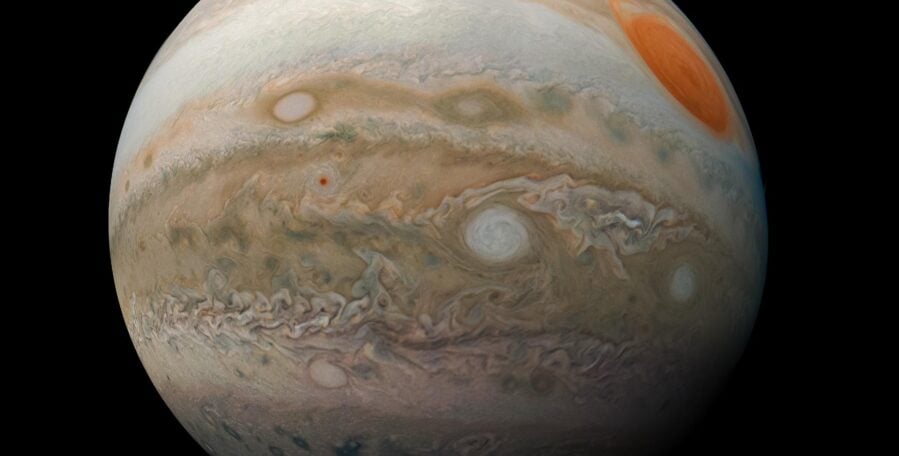Jupiter was a vastly different world in its youth—roughly twice as large as today and wielding a magnetic field 50 times more powerful than its current strength.
New research published in Nature Astronomy reveals that 3.8 million years after the Solar System’s first solids formed, the gas giant was still contracting from its primordial bloated state while accreting massive amounts of material through a surrounding disk of gas and debris.
The findings emerge from an ingenious detective story that combines the orbital dynamics of Jupiter’s small inner moons with the planet’s ancient spin history. By tracking how these satellites moved during Jupiter’s early evolution, scientists have reconstructed a detailed snapshot of the giant planet’s formative years.
Clues Hidden in Moon Orbits
The breakthrough came from studying Jupiter’s inner satellites—particularly Amalthea and Thebe, two small moons that orbit closer to the planet than the famous Galilean satellites. These rocky bodies carry the gravitational fingerprints of their violent past, when the mighty moon Io swept inward through the Jovian system during the planet’s youth.
As Io migrated toward Jupiter billions of years ago, it passed through precise orbital resonances with the smaller moons. These gravitational encounters kicked Amalthea and Thebe into their current tilted orbits, leaving permanent evidence of Io’s starting position when the primordial disk finally dissipated.
The orbital forensics reveal that Io began its inward journey at a distance roughly 1.6 to 1.9 times Jupiter’s current radius. Since Io would have been trapped near the inner edge of Jupiter’s surrounding gas disk, this measurement provides a direct window into the young planet’s size.
A Magnetic Powerhouse
The research team, led by Konstantin Batygin and Fred Adams, used conservation of angular momentum to work backward from Jupiter’s present-day spin rate to its ancient dimensions. Their calculations show Jupiter originally spanned between 2 and 2.5 times its current radius—making it roughly the size of a small star.
This massive young Jupiter generated a correspondingly enormous magnetic field. The planet’s surface magnetic field strength reached approximately 21 millitesla, compared to today’s value of about 0.4 millitesla. This magnetic behemoth was powerful enough to carve out a substantial cavity in the surrounding gas disk, regulating both the planet’s spin and its appetite for new material.
Key findings from the study include:
- Jupiter’s primordial radius was 2-2.5 times larger than today
- The planet’s magnetic field was roughly 50 times stronger
- Jupiter was accreting 1.2-2.4 Jupiter masses worth of material every million years
- The planet’s rotation period was significantly faster than today’s 10-hour day
Shrinking Giant
Why was early Jupiter so enormous? The answer lies in how giant planets form through the core-accretion process. After Jupiter’s rocky core reached a critical mass, it triggered a period of runaway gas accumulation that inflated the young planet to colossal proportions. The newly formed giant was hot, puffy, and still glowing from the energy of its violent birth.
Over millions of years, Jupiter slowly contracted under its own gravity while radiating away its primordial heat. This gradual shrinkage continued long after the surrounding solar nebula disappeared, eventually producing the more compact world we see today.
The timing proves crucial for understanding Solar System history. The research pinpoints Jupiter’s inflated state to exactly 3.8 million years after calcium-aluminum inclusions—the first solid materials—formed in the early Solar System. This timeline comes from meteorite evidence showing when the solar nebula finally dispersed.
Engineering a Solar System
Jupiter’s early evolution had profound consequences for the entire Solar System. The planet’s massive size and powerful magnetic field would have dramatically influenced how smaller worlds formed in the inner Solar System. Its gravitational reach could scatter asteroids and comets while its magnetic bubble deflected charged particles from the young Sun.
The study also reveals how Jupiter’s satellite system took shape. The powerful magnetic field carved out a cavity in the surrounding disk, creating conditions that trapped forming moons and organized them into the resonant chain we observe today. Without this magnetic architecture, the Galilean satellites might never have achieved their current orbital harmony.
What makes this detective work particularly elegant is how it sidesteps the usual uncertainties in planet formation models. Instead of relying on complex theoretical calculations, the researchers used the preserved orbital evidence to directly measure Jupiter’s ancient properties.
As Jupiter continues its slow thermal evolution today, it serves as a reminder that even the most massive planets in our Solar System began as bloated, rapidly spinning worlds very different from their current states. The gas giant that now dominates our outer Solar System was once a magnetic monster twice its current size, ruling over a very different celestial neighborhood.
If our reporting has informed or inspired you, please consider making a donation. Every contribution, no matter the size, empowers us to continue delivering accurate, engaging, and trustworthy science and medical news. Independent journalism requires time, effort, and resources—your support ensures we can keep uncovering the stories that matter most to you.
Join us in making knowledge accessible and impactful. Thank you for standing with us!

